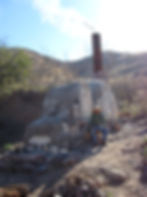









PROCESS
My work partakes of two very different techniques: locally sourced terra cotta clay fired in an electric kiln and salt glazed stoneware and porcelain fired in wood fueled kilns.
Terra Cotta – Just outside of Bisbee, high in the Mule Mtns. is a large deposit of high quality terra cotta clay. I was unaware of its existence until a road put in by a failed real estate development revealed it. The clay is mixed to a liquid state, passed through two screens, and dried to working consistency in a fired adobe rack. Nothing is added. This Bisbee clay is exceptional, on the wheel it is wonderfully plastic, has a rich fired color and glazes fit with few problems. It has some quirks but when treated with respect it more than returns the favor.
Terra cotta pieces are usually glazed with a clear interior glaze which shows the clay color and contrasts with the fat, white exterior glaze which I decorate in a manner inspired by majolica and other earthenware traditions. Fired to 1055 degrees Centigrade in an electric kiln the ware is quite durable.

Salt Glazed stoneware and porcelain - This work is fired to 1280 – 1300 degrees Centigrade in wood fueled kilns. Salt glazing originated in Germany in the fourteenth century and was used extensively in the colonial United States. At these high temperatures salt thrown into the kiln’s fireboxes vaporizes and combines with the silica in the clay to form a strong glaze with something of an orange peel texture. The wood ash passing through the kiln also melts to a glaze. This is an unpredictable and exciting firing.
While the ash and salt can provide sufficient glazing I often use other materials with them including glazes made from mixtures of local clays, sands and wood ashes.
Forming – I love working on the potter’s wheel and by far this is how the majority of my ware is made. When throwing is going well I sometimes feel like a surfer, riding a curve instead of a wave. In recent years I have explored the making of large pots and experimentation led me to hand building these with coils on a turntable made from automobile parts, a wheel but a slow, deliberate one.
Kilns – I do wood firing in two different kilns I built at my rural home. One is based on the Olsen fast fire of about 16 cubic feet capacity and the other is an oriental design called Noborigama in Japanese. It has three chambers built on an incline; a small firebox chamber followed by two ware chambers. To some extent I use whatever wood I can get my hands on for fuel but increasingly I use just Mesquite which grows like a large weed in this area.
